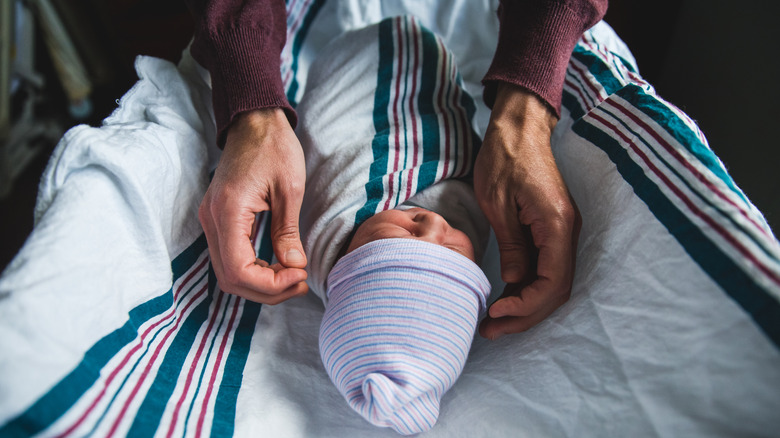
Cavan Images / Rachel Greiman/Getty Images
You don’t have to have had a baby of your own to recognize the baby blanket the majority of infants are wrapped in right after birth. Made of flannel and featuring both pink and blue stripes, these blankets have been used in hospitals since their creation in the 1950s. Sure, it’s a cozy and adorable little blanket to wrap up a new bundle of joy, but with every hospital using them, have you ever stopped to wonder why? Is there an actual reason behind hospitals using this specific receiving blanket? Short answer: yes.
“They’re very absorbent when you first get them. They wash well,” manager of the maternity ward at Advocate Condell Medical Center in Libertyville, Illinois, Nurse Donna Clark told NPR. “They’re the right size for the baby. They’re gender neutral, so we don’t get a dad saying, ‘You’re putting my boy in pink or my girl in blue!'” (Want to know when you can find out the gender of your baby?) With a wholesale price of $2.50 per blanket, they’re also cost-effective for hospitals to buy them in bulk.
These blankets have also become an important part of our collective experience. Because they’ve been used in so many hospitals for over half a century, at this point, the blanket is synonymous with newborns, creating a certain familiarity that’s comforting for not just new parents, but our culture as a whole.
Who makes hospital baby blankets

Purple Collar Pet Photography/Getty Images
You might be surprised to know that this blanket actually has a name: Candy Stripe. Based on the color and design, this makes sense. Candy Stripe is just one of the many blankets in the line of Kuddle-Up Flannel Baby Blankets by Medline. “It was just one of those things that they … (wanted to) make sure that it’s very simple and gender neutral and a stripe was the easiest, most simple way to do that,” director of patient apparel at Medline Industries, Teri Burke, told ABC 15 Arizona. While the other designs include dinosaurs, ducks, baby chicks, as well as a few solid options, Candy Stripe remains the most popular, selling as many as 1.5 million of them every year.
Created by Chicago-based company A.L. Mills, baby blankets weren’t the first thing the business designed; instead, they focused their sights on smocks for butchers in the early 1900s. Even when the company switched gears to make products for use in hospitals, their first invention was a surgical uniform made in green fabric. Green was chosen for operating rooms because of its calming effects, and the fact that in being completely opposite to red, it reduces straining of the eyes, which is paramount during surgery (per Medicus). By the 1950s, A.L. Mills had moved into the baby blanket-making business, and huge success followed. Today, A.L. Mills, now Medline, is a billion-dollar business that specializes in medical supplies, and that blanket they initially designed hasn’t changed at all.
Why you’re not supposed to bring the blanket home

Fatcamera/Getty Images
As much as it’s hard not to love the Candy Stripe blanket and how your infant looks in it, it’s actually supposed to stay in the hospital. It’s called a receiving blanket for a reason, after all. There are a few reasons for this. Not only is it about hygiene — your infant should have their own new and clean blankets at home — but receiving blankets aren’t meant for long-term use, lasting roughly 15 washings and dryings before needing to be replaced. In fact, if you were to look at a nursery in a hospital, you’d see that many of the blankets are very faded from being washed after each use.
But despite this hospital rule, that hasn’t stopped thousands of parents over the years from sneaking the receiving blanket into their belongings before exiting the hospital with their newborn in tow — for sentimental reasons or for a keepsake. Although in some cases, blankets go missing because new parents can be completely frazzled as they’re trying to get their infant out the door and into a car seat. Should you accidentally or on purpose bring one of these blankets home, don’t fret. Hospital workers are more concerned about your baby getting their life started on the right foot than whether or not their parents are blanket bandits.
Credit: healthdigest.com









